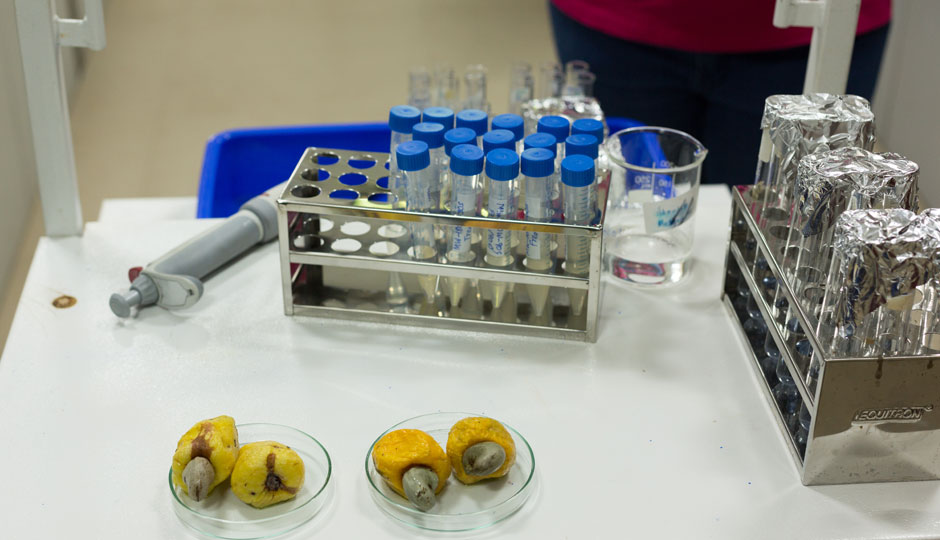 Cashew apple (Anacardium Occidentale L) a tropical fruit of potential economic importance is rich in sugars, tannins, minerals, pigments, antioxidants and vitamins (Vitamin C content is three to six times more than an orange and twelve times more than pineapple), making it a functional food. In addition to vitamin C, it contains thiamine, niacin, riboflavin and precursors of vitamin A and is also found to be good source of minerals, such as copper, zinc, sodium, potassium, calcium, iron, phosphorous and magnesium. The juice recovery of fruit is in the range of 65 per cent to 80 per cent depending upon maturity, variety and process of extraction. Although cashew nuts are widely popular, the use of cashew apple is still restricted. Due to the seasonal nature of production (harvested only during the four-month period – Feb to May), a lack of awareness about the nutritional status of cashew apples and suitable technology for preservation, lakhs of tonnes of cashew apples are wasted every year. Cashew apple juice presents a great potential for both the national and international juice market. Recently, corporate giant PepsiCo tied up with the Clinton Foundation to look at the sustainability model for villages of Maharashtra, by utilizing the cashew apple for blending with popular juices. To explore its full potential, the knowledge of cashew apple processing and preservation methods is essential. Various researchers have tried to improve the shelf life and sensory properties of juice using different methods. The other key problem limiting the acceptability of the cashew apple is its characteristic astringent taste making it less palatable. There is a need to address these problems by developing a technique which is clean, safe, easy to handle, rapid, less energy-intensive and cost effective. Also, the processing should not affect the quality of the product. Various methods have been reported to improve the shelf life and sensory properties of juice using different techniques. To the best of our knowledge, there is no literature reported on the optimization of the process developed so far, which can improve the shelf life of the cashew apple and simultaneously reduce its astringency. The present project is proposed to develop an integrated process (pretreatment assisted membrane separation process) which can help improve the shelf life and simultaneously minimize the astringency of the produce.
Cashew apple (Anacardium Occidentale L) a tropical fruit of potential economic importance is rich in sugars, tannins, minerals, pigments, antioxidants and vitamins (Vitamin C content is three to six times more than an orange and twelve times more than pineapple), making it a functional food. In addition to vitamin C, it contains thiamine, niacin, riboflavin and precursors of vitamin A and is also found to be good source of minerals, such as copper, zinc, sodium, potassium, calcium, iron, phosphorous and magnesium. The juice recovery of fruit is in the range of 65 per cent to 80 per cent depending upon maturity, variety and process of extraction. Although cashew nuts are widely popular, the use of cashew apple is still restricted. Due to the seasonal nature of production (harvested only during the four-month period – Feb to May), a lack of awareness about the nutritional status of cashew apples and suitable technology for preservation, lakhs of tonnes of cashew apples are wasted every year. Cashew apple juice presents a great potential for both the national and international juice market. Recently, corporate giant PepsiCo tied up with the Clinton Foundation to look at the sustainability model for villages of Maharashtra, by utilizing the cashew apple for blending with popular juices. To explore its full potential, the knowledge of cashew apple processing and preservation methods is essential. Various researchers have tried to improve the shelf life and sensory properties of juice using different methods. The other key problem limiting the acceptability of the cashew apple is its characteristic astringent taste making it less palatable. There is a need to address these problems by developing a technique which is clean, safe, easy to handle, rapid, less energy-intensive and cost effective. Also, the processing should not affect the quality of the product. Various methods have been reported to improve the shelf life and sensory properties of juice using different techniques. To the best of our knowledge, there is no literature reported on the optimization of the process developed so far, which can improve the shelf life of the cashew apple and simultaneously reduce its astringency. The present project is proposed to develop an integrated process (pretreatment assisted membrane separation process) which can help improve the shelf life and simultaneously minimize the astringency of the produce.



